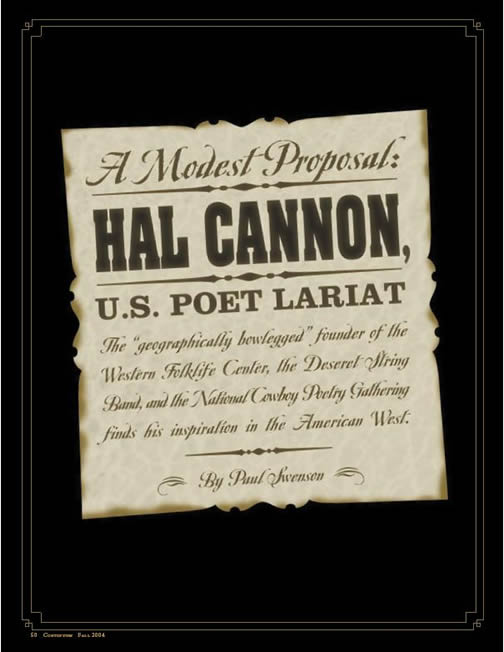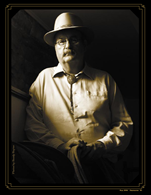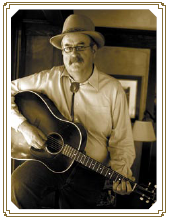
| Vol. 14 No. 2 | Fall 2004 |

The “geographically bowlegged” founder/cofounder of the Western Folklife Center, the Deseret String Band, and the National Cowboy Poetry Gathering finds his inspiration in the American West.
By Paul Swenson
Within days of my first listen to Cluck, Cluck, the debut CD from Hal Cannon’s BS’70 new Secondhand Band, with the poultry-themed traditional tune“Old Hen Cackled, Laid a Double Egg,” my 13-year-old stepdaughter cracked an egg into a frying pan and exclaimed in astonishment, “This chicken had twins!”
Then came a convoluted discussion of the reproductive proclivities of domesticated fowl as captive producers of human breakfast food. The result? A recognizable rash of rural folklore—all of which would likely have tickled folklorist Cannon.
As if discovering fresh eggs from an inexhaustible nest, the founder of the Cowboy Poetry Festival collects anecdotes, songs, poems, and folktales, as well as their sources—cowpoke and cowgirl poets, folk musicians, indigenous storytellers, and other homegrown heroes. And while Cannon, founding director of the Western Folklife Center (Elko and Salt Lake City), churns out media projects for the center, his wife, Teresa Jordan, creates writing and artwork that transect the whole spectrum of Western literature and lore.
 Cannon
met Jordan, who comes from several generations of Wyoming ranchers, while
he was in his first marriage. “One of our staff had heard Teresa
had written a book about cowgirls [Cowgirls: Women of the American West—one
book of seven], and asked her to speak at the Cowboy Poetry Gathering,”
he says. Ten years after Cannon’s divorce, “Teresa and I hung
out some and we fell in love pretty quickly. We’ve been together
13 years and she’s really close to my daughter,” Anneliese,
who returned to Utah after graduate work at Harvard to develop reading
software for the Waterford Institute.
Cannon
met Jordan, who comes from several generations of Wyoming ranchers, while
he was in his first marriage. “One of our staff had heard Teresa
had written a book about cowgirls [Cowgirls: Women of the American West—one
book of seven], and asked her to speak at the Cowboy Poetry Gathering,”
he says. Ten years after Cannon’s divorce, “Teresa and I hung
out some and we fell in love pretty quickly. We’ve been together
13 years and she’s really close to my daughter,” Anneliese,
who returned to Utah after graduate work at Harvard to develop reading
software for the Waterford Institute.
Having returned to Salt Lake six years ago to nest in a historic home just west of the University of Utah, the couple has hatched several new individual and shared projects—Jordan striding boldly into a fresh phase of her career as painter and printmaker, and Cannon revitalizing his musical roots with new takes on traditional and old-timey styles.
Secondhand Band, his new group, is a perfect metaphor for the recycled and lived-in quality of folk music. Cannon and compatriot Tom Carter, a U of U professor of architectural history, are themselves recycled from several other aggregations, notably the celebrated, still extant Deseret String Band. Secondhand’s new element is evocative vocalist and consummate musician Jim Agutter BS’96 MArch’99, also a professor of architecture at the U.
Jumping in with both feet and all fingers flying, Cannon started making his own music as early as the eighth grade—as a founding member of the Stormy Mountain Boys, a Salt Lake bluegrass band, still intact 42 years later. “Brent Bradford BS’70 still runs it and he was in the original group when we started it,” Cannon says. “Different people now, except for him, but it’s amazing he’s kept it going.”
Like any good folktale, Cannon’s introduction to traditional music comes in more than one version. “A visit to his cousin David Pollei’s ex’65 home when he was about 12 changed Hal Cannon’s life,” reports Cannon’s and Jordan’s Web site (FieldnotesWest.com). “When Pollei set an LP of old-time bluegrass on the turntable, Cannon was transported.”
Chatting at a bookstore cafe, Cannon clarifies that blues preceded bluegrass by scant moments in his youthful baptism of musical fire.
“David played me some records he had of Jesse Fuller [‘San Francisco Bay Blues’], and I was just captivated,” he says. Fuller, the blues, gospel, jugband, and ragtime legend, later cited as a major influence by Bob Dylan and the Grateful Dead, among others, had just performed at East High School at the behest of Pollei, an East student who was already a folk music activist.
“Then he played a record called Mountain Music Bluegrass Style,” Cannon says. “I had such a strong reaction. Part of it, I think, was that it seemed a romantic vision of life—grounded and real, in a way that my life wasn’t. It was also sort of foreign or exotic. And it spoke to me from the heart, rather than the mind. I immediately related to it—unlike anything at school or at church. And so, probably mistakenly—or ill advisedly—I took on the music almost as a religion.”
Cannon says that while his friends were okay with their Mormon upbringing (“They had a little more sense of discipline than I did”), he found mostly boredom. “I was a kid who was squirming around all the time, both in church and at school,” he says. One thing he did absorb from his religious legacy was a certain sensitivity to “spiritual occurrences,” he says. When he heard the music, he recognized the feeling.
“When I decided not to go on a mission [for the LDS Church], I felt it was sort of my mission to bring out the folk expression of people and contribute to it myself,” he says. “I immersed myself in rural grassroots music, and I’ve stayed with it longer than anything else.”
When Cannon reached high school, he organized the East High School Folk Music Club, while performing in several folk groups. After receiving his bachelor’s degree in journalism at the U, he acquired a master’s degree in arts education with an emphasis in film from the Rhode Island School of Design in 1972. His natural inclinations, however, were nudging him toward music and folk-friendly pursuits.
After returning to Utah, Cannon, Rich McClure BS’70, and the Jardine brothers, Mark BS’86 BMUS’86 MSW’88 and Steve BA’75 BA’83 MBA’83, launched an enterprise that would outlast even their fondest dreams. Over decades, the Deseret String Band (DSB) would become a living historical compendium of traditional musical styles. Their debut album, Utah Trails, on Hal’s own Okehdokee label, would reveal for many Utahns a hidden musical heritage.
 Renting
a house in the dry, desert beauty of Moab in 1973, the fledgling band
gathered to seek inspiration for the finishing touches to the LP. Steve
Jardine was about to leave the band for an LDS mission, and it was during
that Moab moment that Leonard (Leo) Coulson, a musician Cannon had met
in Rhode Island, showed up for a visit. Soon, Coulson would move west
to fill Steve Jardine’s slot, and, months later, another émigré
and Coulson friend, fiddler Skip Gorman, would meld with the group.
Renting
a house in the dry, desert beauty of Moab in 1973, the fledgling band
gathered to seek inspiration for the finishing touches to the LP. Steve
Jardine was about to leave the band for an LDS mission, and it was during
that Moab moment that Leonard (Leo) Coulson, a musician Cannon had met
in Rhode Island, showed up for a visit. Soon, Coulson would move west
to fill Steve Jardine’s slot, and, months later, another émigré
and Coulson friend, fiddler Skip Gorman, would meld with the group.
For the next 30 years, the Deseret String Band would shuffle both personnel and musical styles (as Ron Kane and Tom Carter moved in and out of the group, and DSB’s first female member, Meghan Merker, came on board). Over the years, the band has riffled through Utah pioneer songs, Celtic tunes, old-time Southern dance music, and, in the early 1980s, under the pseudonym “Bunkhouse Orchestra,” a full complement of Western string band material.
While recording a variety of LPs for Okehdokee, DSB toured
the Fleadh (All-Ireland Music Festival), the National Folk Festival in
Washington, D.C., Great Britain, Ireland, Switzerland, Japan, and Alaska.
In more recent days the group
has played as the official band for the American Cup-winning America3
team at events in California and New England, and represented the Salt
Lake Olympic Committee at bid events in Salt Lake and Birmingham, England.
Cannon left DSB after performances in the 2002 Olympic Winter Games.
While the string band found early success in buoyantly bucking the tide of every American popular music trend, Cannon also caught a fresh wave of what he calls “happenstance” from the National Endowment for the Arts, which began funding state folk arts programs.
“In 1976, I got involved as the folk arts coordinator for the Utah Arts Council,” he says. “I started putting exhibits together and producing videos and records. I was just sort of inclined to organize things and take a producer’s role in working with people. I did that for 10 years.”
Asked if what Cannon does—essentially helping people reconnect with their own humanity—isn’t an anomaly amid modern life trends, he says, “Yes, I think so. It feels like I’m going against the tide in all I do. I’m so used to it,” he smiles, leading one to believe he enjoys his role as renegade romanticist.
“I love it,” he confirms. “I’m really glad I get paid for it.”
It’s been two decades since Cannon founded the National Cowboy Poetry Gathering in Elko, Nev., where the 20th anniversary bash was celebrated in January.
During the evolution of the gathering, his cowboy com-munity has embraced Hispanic vaqueros, Native American buckaroos, Australian stockmen, and Mongolian horsemen. And, he says, “I’ve seen the rise of ranch women writing poetry and their voices are very strong.”
Cowboy ethics go back to Shakespeare, Cannon says. “He talked about judging people by how they treated their horses. A horse doesn’t care if you’re a prince or a pauper, but knows if you relate to him, if you have skill as a horseman,” he says. In the cowpoke community, it takes only body language to “know if you’re around brothers and sisters,” since there’s usually a certain bowleggedness that gives you away.
Cannon’s family was geographically bowlegged— “one foot in the country and one in the city.” So he knew from experience that cowhands weren’t necessarily all laconic “yup” and “nope” sorts of people, as stereotyped in the movies. But when he first sought ranchers who could rein in a metaphor, he was “laughed out of the cattle auction in southern Colorado,” he reports.
“When I asked, ‘Are there any cowboy poets?’ people looked at me funny. ‘Cowboys?—poets?’ ” But 20 years after the first gathering in 1985, the poets themselves have mostly generated the power of what he calls “an artistic grassroots movement.” And now, in the cowboy world, “I’m sort of a known quantity,” he says.
Lately, however, Cannon records a lot of people “who have no idea who I am. Last week, we were downstate recording Navajo songs about the Grand Canyon and Zuni emergence stories from the Grand Canyon. We’re doing a CD for Smithsonian Folkways [Records] from the Grand Canyon.”
Cannon is sensitive to vernacular poetry of all kinds. “If I hear that there’s a fireman, for instance, who writes beautiful poems about his life, my ears perk up. I have antennae for that,” he says. Recently, “we recorded the sort of pre-eminent river-runner poet in the country—he’s 81 years old. I don’t know if anyone had ever recorded him before.”
Cannon’s radio and television work for National Public Radio and the Public Broadcasting System (PBS) casts an even wider lariat in rounding up people from all walks (and rides) of life to present their poems, songs, and stories. Cannon and Jordan’s joint radio project, The Open Road: Exploring America’s Favorite Places, encompasses a host of disparate characters and locales.
In one vignette, a singer-songwriter’s tune describing his own childhood, “Don’t Laugh at Me,” launches a 17-state character education program in the schools, “Operation Respect,” during which hundreds of children sing the song back to him. In another, a long-haul trucker whom Cannon follows to a Nevada brothel—Donna’s Ranch—introduces him to a woman whose relationship with the trucker transcends our expectations.
Cannon and Taki Telonidis’ documentary film, Why the Cowboy Sings, which aired on PBS in 2003, received a Rocky Mountain Emmy and a Special Jury Award at the Houston Film Festival.
Among Cannon’s honors, which include three Wrangler Awards from the Cowboy Hall of Fame, the 1998 Will Rogers Lifetime Achievement Award, and Utah Governor’s Awards for both Arts and Humanities, he appears especially pleased to have just been inducted into Salt Lake’s distinguished (but increasingly less stuffy) Alta Club. “They asked me to be their first laureate, something they’ve never had before,” Cannon beams.
Which suggests one additional honor that someone ought to propose: How about Hal Cannon for U.S. Poet Lariat?
—Paul Swenson is an adjunct faculty member in the Department of Communication at Utah Valley State College (UVSC). His debut collection of poetry, Iced at the Ward, Burned at the Stake and Other Poems, published by Signature Books in December 2003, was a finalist for a 2003 Utah Book Award. This is his first article for Continuum.